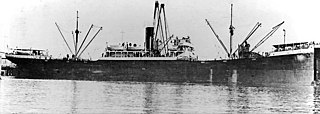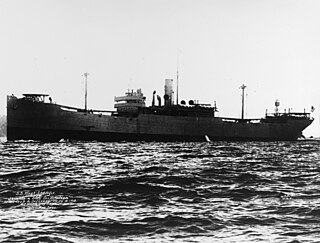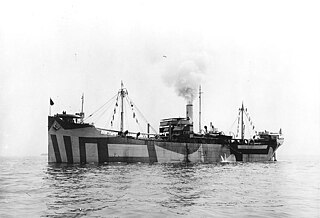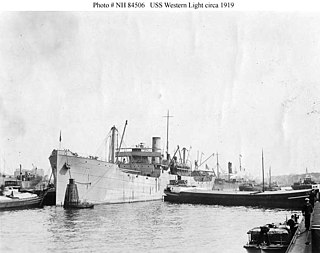
USS George F. Elliott (AP-13) was a Heywood-class transport acquired by the U.S. Navy during World War I and then reacquired by the Navy for service as a troop carrier during World War II. In 1942, she was attacked off Guadalcanal by Japanese planes and sank shortly thereafter.

The SS Empire Miniver was a British steam merchant ship. She was originally an American merchant, launched in 1918 as SS West Cobalt. During a brief stint in the United States Navy in 1919, she was known as USS West Cobalt (ID-3836).

USS Bali was a Dutch cargo steamship that was built for Stoomvaart Mattschappij Nederland in 1917. She served in the United States Navy, with the ID number ID–2483, from March 1918 until May 1919. She supplied the American Expeditionary Forces in France, and in 1919 she took food relief to Europe.

USS West Alsek (ID-3119) was a cargo ship in the United States Navy during World War I. She had been built as SS West Alsek for the United States Shipping Board (USSB) as part of the West boats, cargo ships built on the West Coast of the United States. She sailed on two voyages for the U.S. Navy before she was decommissioned after the Armistice.

USS West Carnifax (ID-3812) was a cargo ship in the United States Navy shortly after World War I. After she was decommissioned from the Navy, the ship was known as SS West Carnifax, SS Exford, and SS Pan Royal in civilian service under American registry.

MS West Grama, sometimes spelled as West Gramma, was a diesel-powered cargo ship of the United States Maritime Commission (USMC) that was sunk as part of the "gooseberry" breakwater off Utah Beach during the Normandy invasion. Prior to her diesel conversion, she was known as SS West Grama. In 1919, she was briefly taken up by the United States Navy under the name USS West Grama (ID-3794).
USS Hisko (ID-1953) was a tanker that served in the United States Navy from 1917 to 1919.

The second USS Wachusett (ID-1840) was a cargo ship that served in the United States Navy from 1918 to 1919.

USS West Lianga (ID-2758) was a cargo ship for the United States Navy during World War I. She was later known as SS Helen Whittier and SS Kalani in civilian service under American registry, as SS Empire Cheetah under British registry, and as SS Hobbema under Dutch registry.

USS Suwanee (ID-1320) was a United States Navy transport in commission in 1919. She was the second ship to carry her name.

USS Aniwa (ID-3146) was a steel-hulled, single-screw cargo ship that served in the United States Navy from 1918 to 1919.

West Madaket was a steam cargo ship built in 1918–1919 by Skinner & Eddy Corporation of Seattle for the United States Shipping Board as part of the wartime shipbuilding program of the Emergency Fleet Corporation (EFC) to restore the nation's Merchant Marine.

SS West Mahomet was a steel–hulled cargo ship which saw service as an auxiliary with the U.S. Navy in 1918–19.
USS West Mead (ID-3548), also spelled Westmead, was a United States Navy cargo ship in commission from 1918 to 1919.

USS Berwyn (ID-3565) was a United States Navy cargo ship in commission from 1918 to 1919. She saw service in the final weeks of World War I, then entered commercial service in 1919 as SS Berwyn. She was wrecked in 1920.

Western Sea was a steam cargo ship built in 1918 by J. F. Duthie and Company of Seattle for the United States Shipping Board as part of the wartime shipbuilding program of the Emergency Fleet Corporation (EFC) to restore the nation's Merchant Marine.

USS Westpool (ID-3675) – sometimes written as West Pool – was a cargo ship of the United States Navy that served during World War I and its immediate aftermath. As SS Westpool, she was sunk during World War II after being sold to the United Kingdom for use as a merchant ship.

USS Western Light (ID-3300) was a cargo ship of the United States Navy that served during World War I and its immediate aftermath.`

USS Western Chief (ID-3161) was a cargo ship of the United States Navy that served during World War I and its immediate aftermath. As SS Western Chief, she was sunk during World War II after being sold to the United Kingdom for use as a merchant ship.

USS Saetia (ID-2317) was a United States Navy cargo ship in commission in 1918 that was sunk during World War I.

















